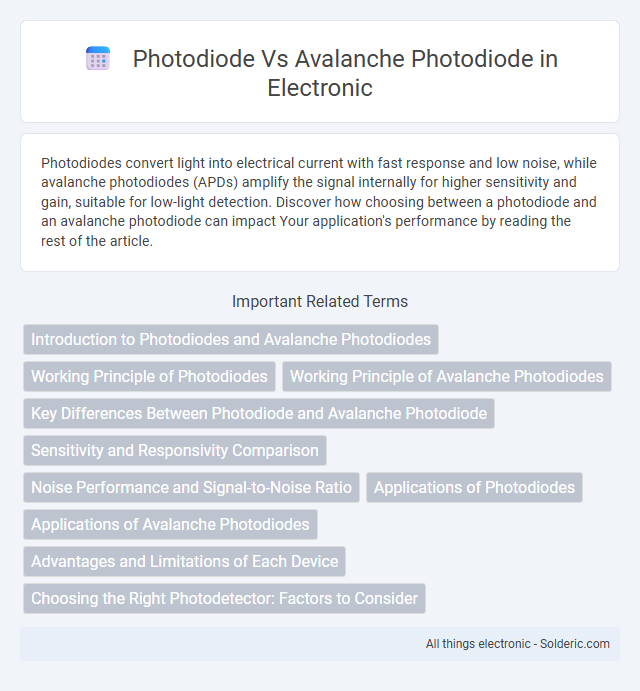Photodiodes convert light into electrical current with fast response and low noise, while avalanche photodiodes (APDs) amplify the signal internally for higher sensitivity and gain, suitable for low-light detection. Discover how choosing between a photodiode and an avalanche photodiode can impact Your application's performance by reading the rest of the article.
Comparison Table
| Feature | Photodiode | Avalanche Photodiode (APD) |
|---|---|---|
| Operating Principle | Generates current by absorbing photons | Uses internal avalanche multiplication for gain |
| Sensitivity | Moderate sensitivity | High sensitivity with internal gain |
| Gain | No internal gain (gain = 1) | High internal gain (up to 100+) |
| Bias Voltage | Low reverse bias (typically < 10 V) | High reverse bias (50-200 V) |
| Noise | Lower noise | Higher noise due to avalanche effect |
| Speed | Faster response time | Slower than standard photodiodes |
| Applications | General light detection, low-cost sensors | Low light detection, LIDAR, fiber optics |
| Cost | Lower cost | Higher cost |
Introduction to Photodiodes and Avalanche Photodiodes
Photodiodes are semiconductor devices that convert light into electrical current, widely used for optical communication and sensing applications due to their fast response and high sensitivity. Avalanche photodiodes (APDs) operate with a high reverse bias voltage, enabling internal signal amplification through impact ionization, which significantly enhances their sensitivity and makes them ideal for low-light detection. Both devices rely on the photoelectric effect, but APDs offer higher gain and improved signal-to-noise ratio, crucial for precise photon counting and long-distance fiber optic systems.
Working Principle of Photodiodes
Photodiodes convert light into electrical current based on the photovoltaic effect, where incident photons generate electron-hole pairs in the semiconductor material. Avalanche photodiodes (APDs) enhance this process by applying a high reverse-bias voltage to create an internal gain through impact ionization, multiplying the generated charge carriers for increased sensitivity. Your choice between a standard photodiode and an APD depends on the required detection sensitivity and speed in optical communication or sensing applications.
Working Principle of Avalanche Photodiodes
Avalanche photodiodes (APDs) operate by converting light into electrical current through the photoelectric effect, followed by internal carrier multiplication via avalanche breakdown. When incident photons generate electron-hole pairs in the semiconductor, a high reverse-bias voltage accelerates these carriers, causing impact ionization and resulting in a significant multiplication of charge carriers. This internal gain mechanism enhances sensitivity and allows APDs to detect low-intensity light signals with high speed and precision, distinguishing them from standard photodiodes.
Key Differences Between Photodiode and Avalanche Photodiode
Photodiodes convert light into electrical current with moderate sensitivity and fast response, making them ideal for general optical sensing applications. Avalanche photodiodes (APDs) provide internal gain through avalanche multiplication, resulting in higher sensitivity and improved performance in low-light conditions, but they require higher bias voltage and exhibit increased noise. Your choice between these devices depends on the needed sensitivity, response speed, and operating voltage for your specific optical detection requirements.
Sensitivity and Responsivity Comparison
Avalanche photodiodes (APDs) exhibit significantly higher sensitivity and responsivity compared to standard photodiodes due to their internal gain mechanism through avalanche multiplication, which amplifies the photocurrent generated by incident light. Standard photodiodes offer faster response times but lower sensitivity, making them suitable for low-gain applications, while APDs provide enhanced detection of weak optical signals in low-light environments. Your choice between these devices depends on the required balance between speed and sensitivity for precise optical measurements.
Noise Performance and Signal-to-Noise Ratio
Photodiodes generally exhibit lower noise performance due to their simple p-n junction structure, resulting in a moderate signal-to-noise ratio (SNR) suitable for many standard optical detection applications. Avalanche photodiodes (APDs) leverage internal gain through impact ionization, significantly enhancing SNR by amplifying weak optical signals but at the cost of increased excess noise and higher dark current. Optimizing APD performance involves balancing gain settings to maximize SNR while minimizing noise contributions, making them ideal for low-light and high-speed communication systems.
Applications of Photodiodes
Photodiodes are widely used in applications such as optical communication, light sensing, and medical imaging due to their fast response and high sensitivity to light. Avalanche photodiodes (APDs), offering internal gain through avalanche multiplication, are preferred in low-light conditions and high-speed optical receivers like LIDAR and fiber-optic networks. Standard photodiodes excel in environments requiring stable, linear light detection without the need for the high bias voltage required by APDs.
Applications of Avalanche Photodiodes
Avalanche photodiodes (APDs) are extensively used in high-speed optical communication systems, including fiber-optic networks and LIDAR technology, due to their superior sensitivity and internal gain. Applications in medical imaging, such as positron emission tomography (PET), leverage APDs for their ability to detect low levels of light with high accuracy. They are also critical in quantum cryptography and photon counting experiments where detecting single photons with high efficiency is essential.
Advantages and Limitations of Each Device
Photodiodes offer high-speed response and low noise levels, making them ideal for general optical detection applications, but they have limited sensitivity under low-light conditions. Avalanche photodiodes (APDs) provide internal gain through impact ionization, resulting in higher sensitivity and enhanced signal-to-noise ratio critical in low-light or long-distance communication scenarios. However, APDs require higher operating voltages and suffer from increased noise and temperature sensitivity, which complicates their use in certain environments.
Choosing the Right Photodetector: Factors to Consider
When choosing the right photodetector, consider the key differences between photodiodes and avalanche photodiodes (APDs) such as sensitivity, noise level, and response speed. Photodiodes offer lower noise and simpler operation, making them ideal for low-light applications, while APDs provide higher gain and better sensitivity for detecting weak optical signals in high-speed communication systems. Your choice should align with factors like required detection sensitivity, bandwidth, and operational complexity to optimize performance in your specific application.
Photodiode vs Avalanche photodiode Infographic

 solderic.com
solderic.com